News
21 December 2018 - Tourist Organization of the Municipality of Budva and the Association of Caterers of Budva are organising the event Christmas Piazzetta which should additionally complement the city's tourist offer during the upcoming Christmas and New Year holidays.
This event will take place from December 22 to January 15 at the Budva’s City Park. The program of the Christmas Piazzetta will include a vibrant music and entertainment program, exhibitions of souvenirs and handicrafts, as well as the offer of drinks and delicacies exhibited by numerous caterers from Budva.
The program of the Piazzetta is designed to suit all ages and tastes, so the organisers have prepared activities dedicated to the youngest audience, evening events when cocktail masters will entertain and serve visitors, costume nights and more!
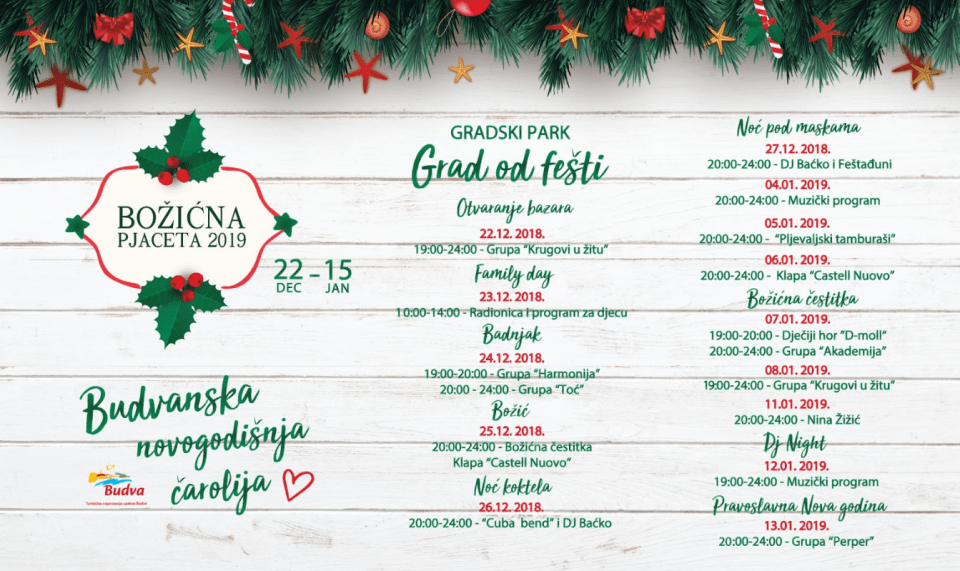
This Sunday (December 23) is reserved for the youngest - from 10 am to 2 pm there will be a music and entertainment program which will include children from Public Preschool Institution "Ljubica Jovanović-Maša", PPI "My World” and PPU" Winnie the Pooh", dance group "Iskra" and members of the Youth Club Budva. A creative workshop for children will also be organized, in which the little ones can make greeting cards, ornaments, and souvenirs. Their handicrafts will be sold, and this will raise funds for the purchase of wheelchairs for the needs of the "Second primary school" in Budva, attended by children with disabilities.
On December 24, from 19:00 to 20:00, the guests will be entertained by the sounds from the band Harmonija, followed by the band Toć from 20:00 to 24:00.
On December 25, the organisers have prepared a Christmas Celebration from 20:00 to 24:00, with the Castell Nuovo band.
Numerous locals have already shown great interest in the Night of Cocktails (December 26th) and Costume Night (December 27th).
The Christmas Piazzetta, which takes place from December 22 to January 15, offers a unique and rich musical program that can suit the tastes of all guests - from the fans of rock and pop sounds, those who prefer electronic music, to those who enjoy the wonderful sounds of tambourines.
21 December 2018 - The Fifth New Year's Fair of Local Products was officially opened on December 21st at the Sports Centre in Nikšić.
Nearly 250 producers from Nikšić and other Montenegrin municipalities, as well as from the region, are exhibiting their products at this economic-tourist event, established four years ago as a local product fair.
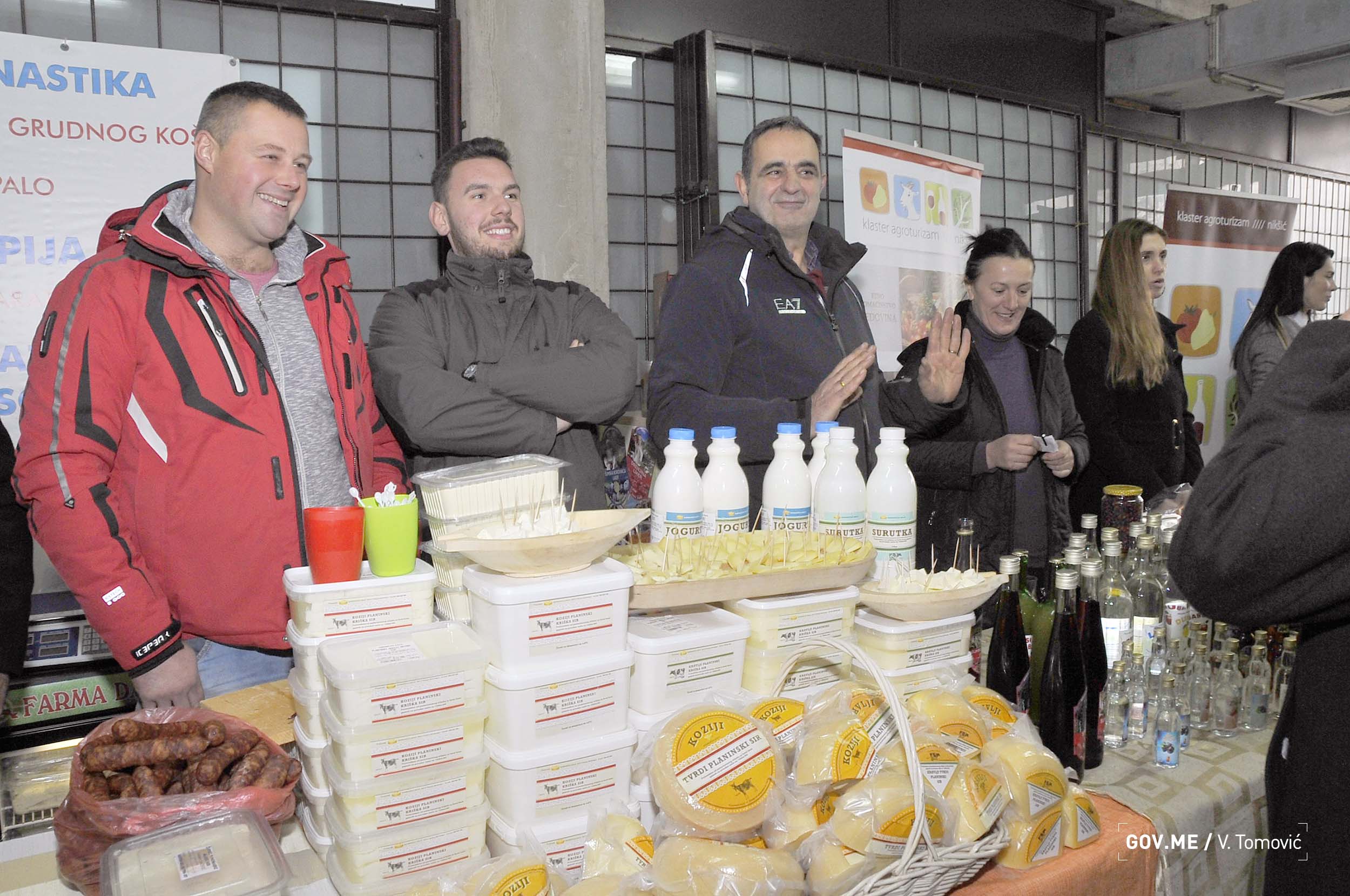
The fair has justified the expectations of the organizers in a relatively short period because it is obviously becoming one of the official brands of the city of Nikšić and an event that delights both the exhibitors and visitors. This event is an exceptional opportunity for the promotion of food products, healthy lifestyle, artisan work, and artwork, as well as for the encouragement of fellow citizens to buy local products. The exhibitors of the fair prepare themselves several months ahead of the event to make sure they offer the best and highest quality products to the visitors.
The Fair of Local Products also offers an excellent opportunity for establishing new contacts, exchange of information and knowledge about the latest trends in production and consumption, as well as a chance for the producers to promote their own business efficiently.
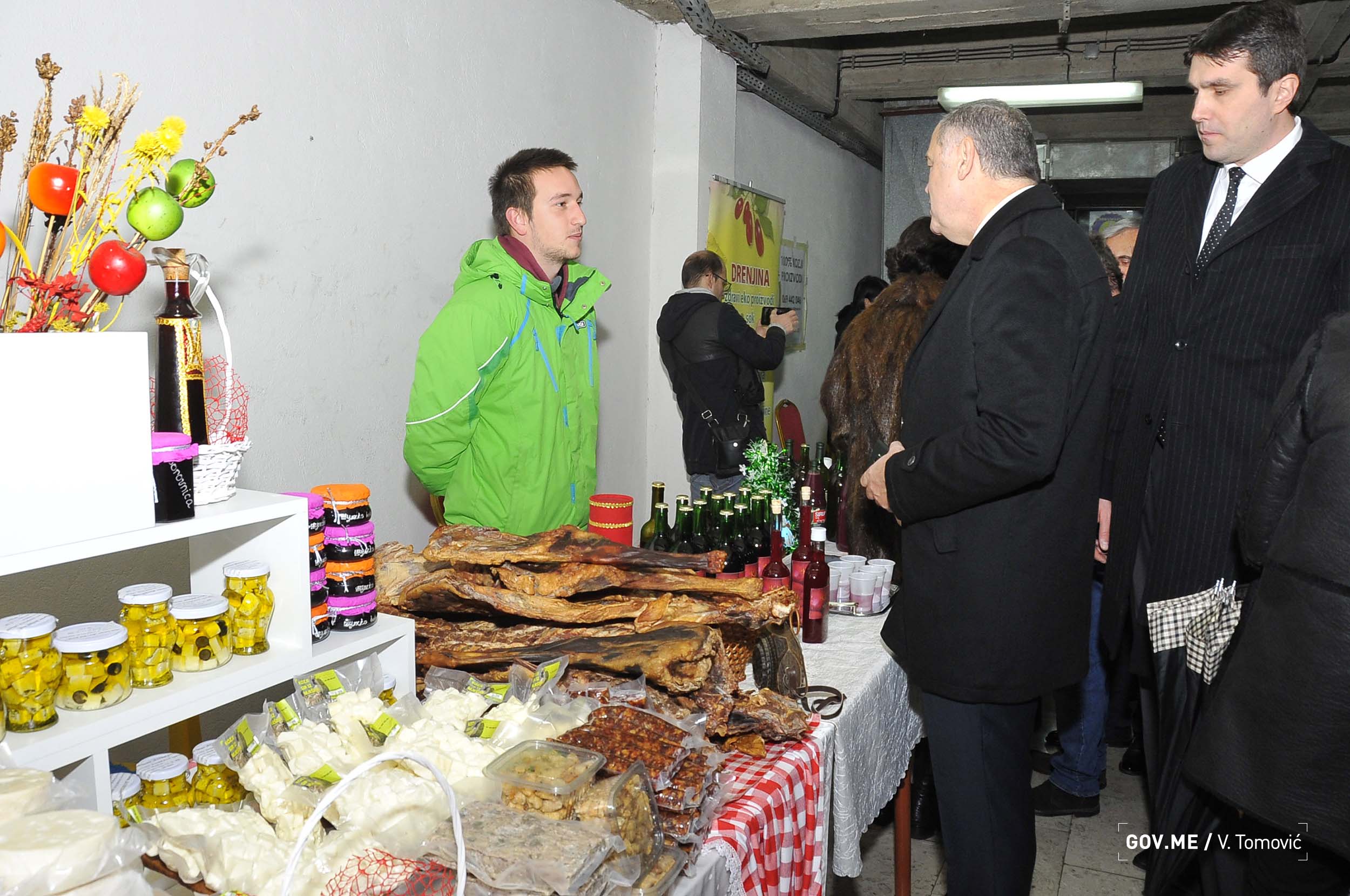
This year, the exhibitors offer large quantities of various products, from food products such as homemade liqueurs, honey, juices, sweet, brandy and balsam, goat and cow milk products, traditional Montenegrin prosciutto, to various handicrafts that can serve as souvenirs or gifts - embroidered trousers, socks, etc.
Deputy Prime Minister and Minister of Agriculture and Rural Development, Milutin Simović, who opened the fair in Nikšić, said that the achieved results in the agricultural sector are the best confirmation that the opportunities for a successful business in this sector are becoming more and more apparent and accessible.
The Local Product Fair is organized by the Municipality of Nikšić, with the support of the Ministry of Agriculture and Rural Development, Entrepreneurship and Innovation Centre Tehnopolis and NGO "Rural Development Network". This year's partner of the Fair is the Municipality of Bijelo Polje that supported the participation of producers from the city.
New Year's Fair of Local Products will be held from December 21 to 23, 2018.
21 December 2018 - Starting from 1 January 2019, the excise duties on fine-cut smoking tobacco will increase from 30 to 35 EUR per kilogram, on ethyl alcohol from 1.050 to 1.250 EUR per hectolitre and on carbonated drinks from 20 to 25 EUR per hectolitre, the Ministry of Finance reported. This means the price of these products would increase, but there is still no information on how much.
The Ministry of Finance reminded of the excise tax calendar which entered into force as of August 2018, when the excise tax on the fine-cut smoking tobacco decreased from 54 to 30 EUR per kilogram (this price is valid from 1 September to 31 December 2018).
From 1 January to the end of 2019, the excise tax on fine-cut smoking tobacco will be 35 EUR per kilogram, from 1 January to 31 December 2020 – 40 EUR, in 2021 – 45 EUR, while in 2022 it will amount to 50 EUR per kilogram.
The Ministry also stated that so far it has generated 37.6 million EUR from excise taxes on tobacco product, which is by 26.6% or 13.6 million EUR higher compared to the same period last year.
Nevertheless, the import of fine-cut smoking tobacco in the country has not increased even though many people started using it.
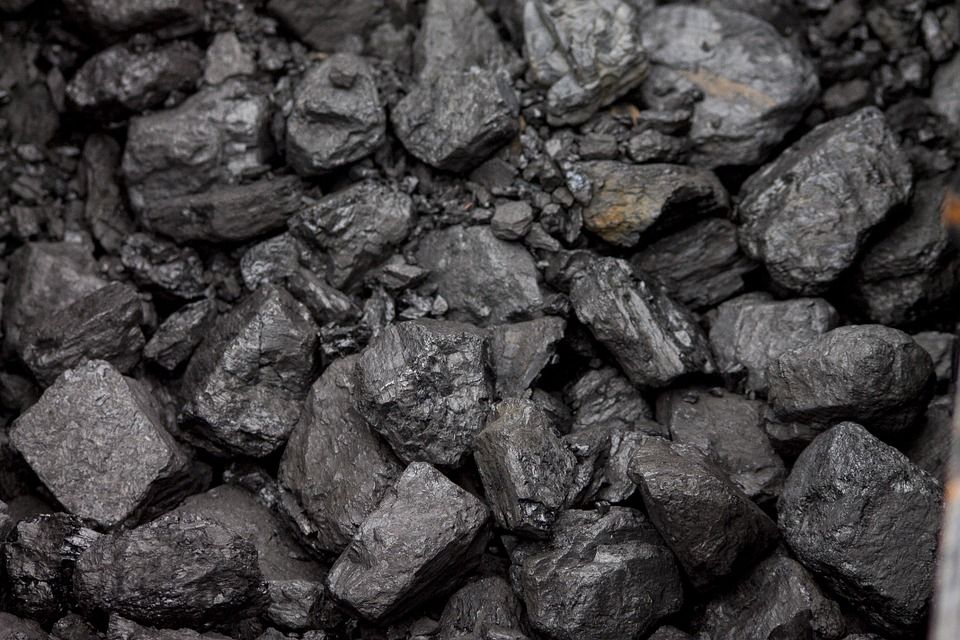
Similarly, excise on coal will increase the selling price of it, from 1,4 to 2,2 EUR per ton. Representatives of the Electric Power Company of Montenegro said that coal price had an impact on the production price of electricity produced in the thermal power plant.
However, Electric Power Company of Montenegro decided last week that they would not change the prices of electricity. New regulation stipulates that the electricity price for distributive consumers be formed by the market price from the reference energy stock in Budapest, with specific limitations. Production of electricity in Montenegro has minimum impact on that stock, and thus minor disturbances, like excise on coal, can not seriously affect the stock in Budapest, which is a referent for electricity prices in Montenegro.
Starting from 1st January, 15 cents excise on coal will be levied. Starting from 1st January of 2020, it will double (30 cents per gigajoule of gross heat value). Representatives of Coal Mine said that they would introduce special season discounts for the households, and they would be higher than the excise. Coal price is one of several parameters which have an impact on electricity price.
“At this moment, we don’t know whether the excise will have an impact on electricity prices”, said the representatives of the Coal Mine.
Excise on coal is related to the calorific value of coal, and it will have an impact on an increase of operating costs of the Coal Mine.
Source: Cafe del Montenegro
21 December 2018 - An international multidisciplinary systematic field research and study of the music and dance tradition and customs of Paštrović, titled Ethno Lab, which took place in Petrovac from December 10th to December 16th, has been completed.
This project is organized for the second year in a row by the Society for Cultural Development "Bauo" from Petrovac. The project was supported by the Municipality of Budva, HG Budva Riviera and the Tourist Organization and the Municipality of Budva, while the assistance was provided by Museums and Galleries of Budva and the families of Marina and Ilija Medin.
Several reference ethnomusicologists, ethnocorists, ethnologists and anthropologists, as well as other experts and researchers in the field of cultural heritage living and working in Montenegro, Serbia and Bosnia and Herzegovina have contributed Ethno Lab project, including Zlata Marjanović (Academy of Arts Banja Luka), Dragica Panić Kašanski (Academy of Arts, Banja Luka), Vesna Karin (Academy of Arts, Novi Sad), Martina Karin (Academy of Arts, Novi Sad), Miloš Rašić (Ethnographic Institute SANU, Belgrade) and many others.
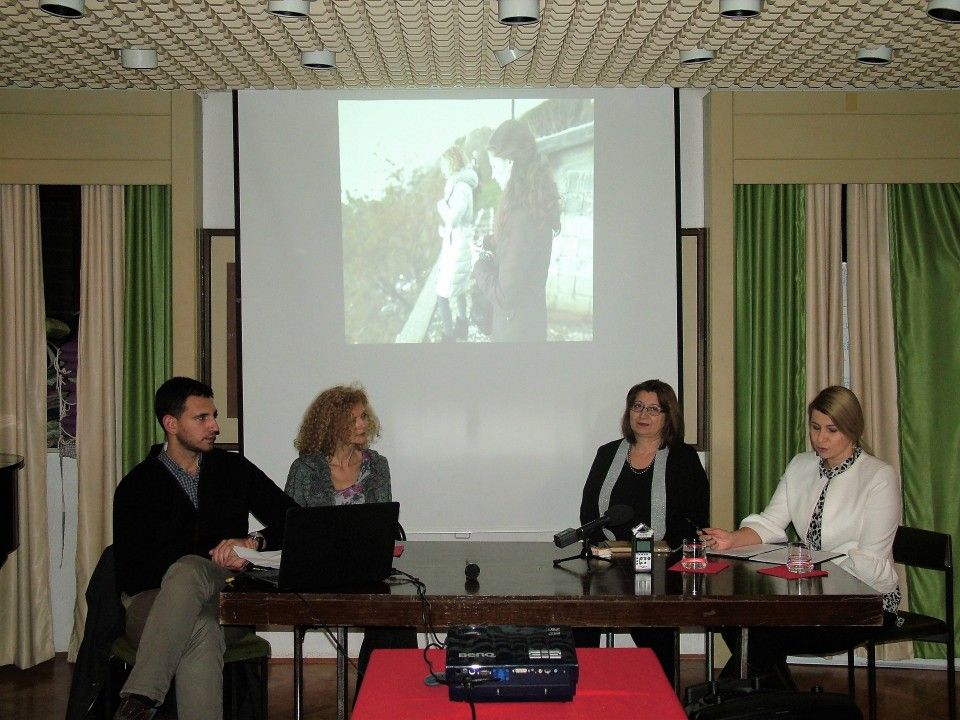
Professional associates on the project were Dušan Medin, archaeologist and master manager in culture, doctoral studies in archaeology at the Faculty of Humanities at the Faculty of Humanities in the Maritime University in Koper (Republic of Slovenia), also a longtime researcher of the material and non-material cultural heritage of Paštrovići, Milica Stanić Radonjić, Master of Communication (Museums and Galleries of Budva) and Itana Lalović, ethnologist and anthropologist (Museums and Galleries of Budva) and marketing advisor. The coordinator of the project is Mila Medin, executive director of the Society for Cultural Development "Bauo", which assisted in coordination and organization to 5 volunteers.
During this year's project, successful research was conducted, and a lot of valuable material was collected through interviews with twenty families of Paštrović.
As in the past year, it is expected that the results of the research will affirm the rich and representative intangible cultural heritage of Paštrovići, which, despite the current knowledge and results, is still multidisciplinary scientific study and valorization.
On each day of the project more discussions with the local population were organized, while on Saturday, December 15th, at the Memorial House "Red Commune", a lecture was held on which participants presented the project, the current research, and future development prospects in the future.
One of the ideas that was born during the research is the treatment of more recent issues.
"Why wait for someone to come in for 50 years and deal with some topics from the 1970s and 1980s when we now have younger people who I can talk to about that period. These are the topics and research we want, and they should be implemented as soon as possible," concluded Mila Medin, the executive director of the Bauo Cultural Development Society and the coordinator of the Ethno Lab project.
20 December 2018 - The implementation of the “Smart City Concept” within the Capital City of Montenegro includes the realisation of a pilot project related to the introduction of modern technologies, especially the promotion of the use of solar energy.
Podgorica has recently purchased six “Smart Solar Benches” of the new generation, which, through installed photovoltaic modules, accumulate solar energy as the only power source (the benches are not connected to any source of electricity). Generated solar energy allows the collection of data about the weather parameters that will be available to citizens through an application that the Capital will develop in the upcoming period. The bench has a WiFi access point, a rain sensor that turns off the bench in the case of heavy precipitation, a built-in LED light that illuminates the area near the bench at night. Users also have the option to wirelessly charge their newer generation devices (which support wireless charging), as well as standard device charging via two USB ports.
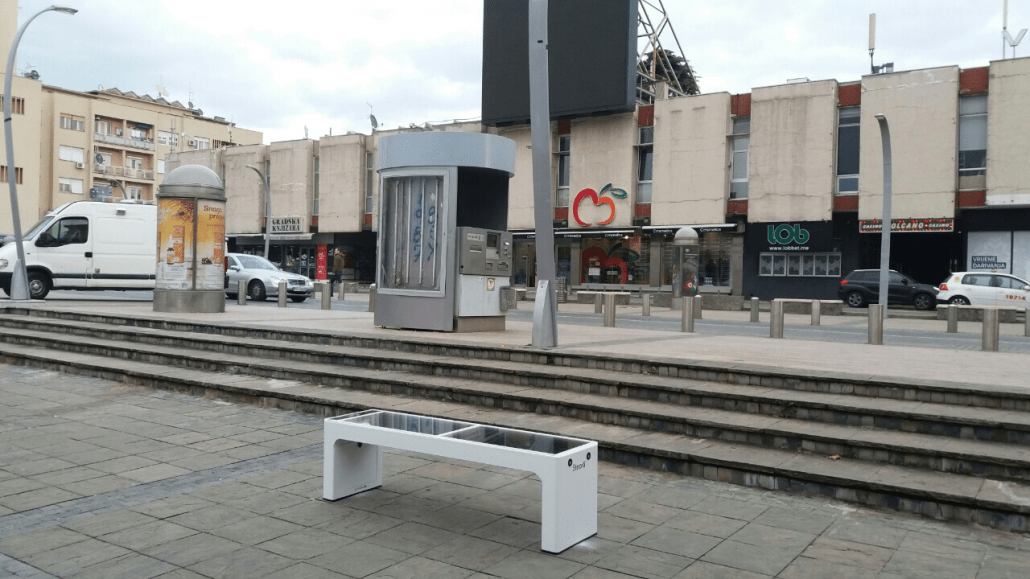
The benches can be found in five city locations, which had to satisfy the basic conditions for the functioning of the bench - direct exposure to the sun, and the frequency of citizens' movements.
There are two Smart Solar Benches at the Independence Square, one at the Square Argentina, one at Roman Square (Rimski trg) - between the cafés Astoria and Primicia, one near the Square of Vojvoda Bećir-Beg Osmanagić (the Stara Varoš district, in front of the Natural History Museum) and one at Zabjelo district, at the March 27 Street (near the Primary school "Vuk Karadžić").
Dragutin Đeković, head of the International Cooperation Service, said that this is only the first step in the introduction of modern technologies in Podgorica and their application in the field of environmental protection. He announced that in the forthcoming period, the Capital would set up a network of sensor stations that will continuously monitor air quality parameters and that in January 2019, the first phase of replacing current public lighting with LED technology will begin.
20 December 2018 - In summer 2019, Montenegro Airlines is adding new service to Germany, with the scheduling of Tivat - Hannover route. From May 2, 2019, Fokker 100 aircraft will serve this route twice a week.
The representatives of the company Montenegro Airlines have announced that in the forthcoming so-called "IATA Summer Season” (International Air Transport Association Summer Season), which starts on the last Sunday of March and ends on the last Saturday of October, they will introduce yet another new destination from Tivat Airport. They revealed that they had secured a route to and from the German city of Hannover. Montenegro Airlines’ aircraft will take passengers from Germany to explore the delights of Montenegro from May 2, 2019, and this aircraft will ride weekly, on Thursdays and Sundays. The departure time from Hannover to Tivat, which is already determined, is 09:16, while the arrival time is 11:30. Fokker will take passengers from Montenegro to Germany also on Thursdays and Sundays, with the departure time 06:30 and the arrival time 08:35.
Flights will run with the 102-seat Fokker 100 aircraft. During the 2018 summer season, Montenegro Airlines launched seasonal operations from Tivat to Munich, Leipzig, and Copenhagen. However, services to Copenhagen are not scheduled to resume next year, while flights to both Munich and Leipzig will increase to three flights a week for both destinations.
Montenegro Airlines is the flag carrier of Montenegro that operates scheduled and charter services throughout Europe from its hub at Podgorica Airport with a second base maintained at Tivat Airport. The company’s aircraft are recognizable by their high-quality performances, superior ergonomics, and outstanding effectiveness and efficiency. With the acquisition of modern aircraft, they offer the most pleasant and comfortable flights to their passengers. Montenegro Airlines has a reputation for a safe and reliable company that continues to grow in every aspect.
Details for the new Tivat - Hannover service can be found at EX-YU Aviation Website.
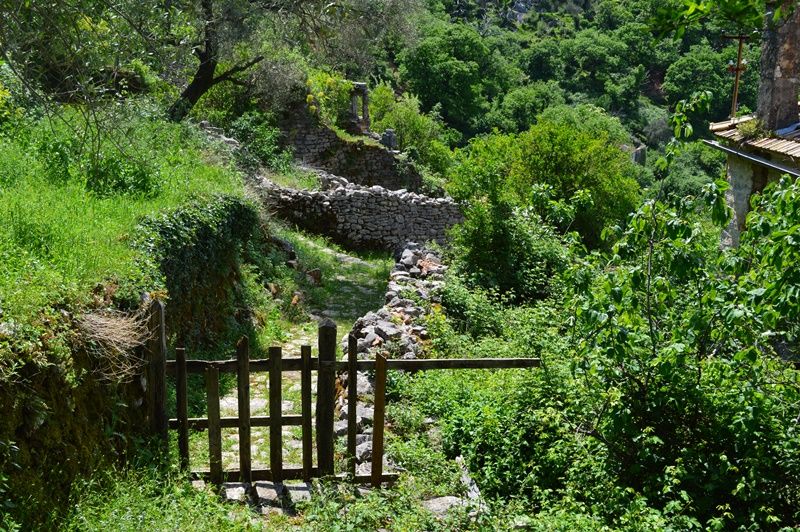
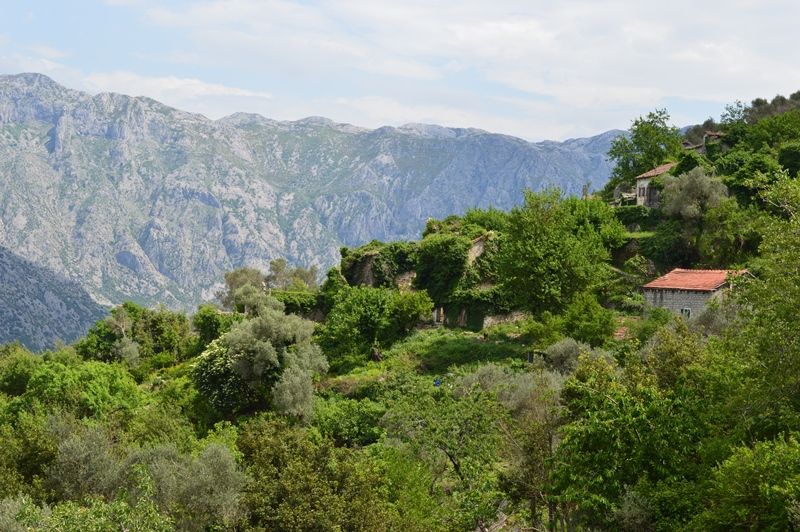
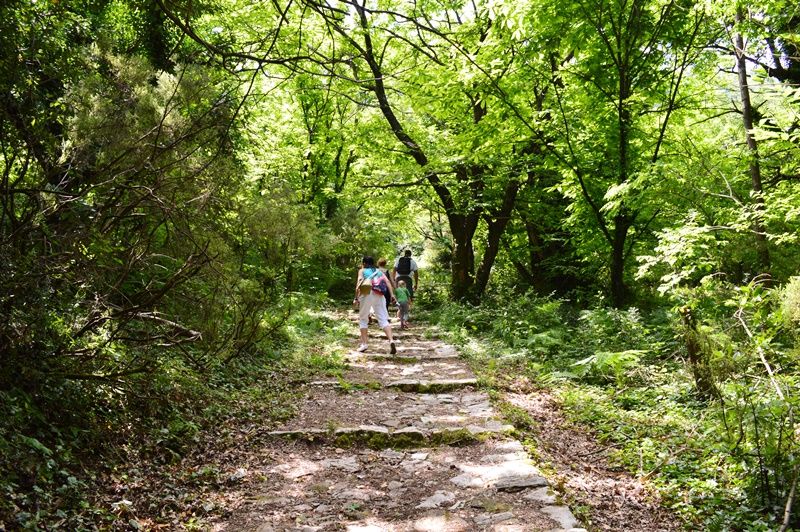
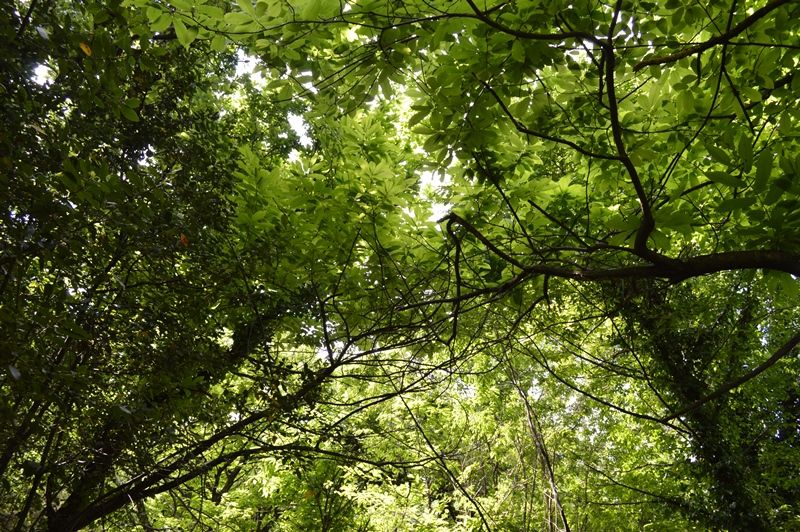
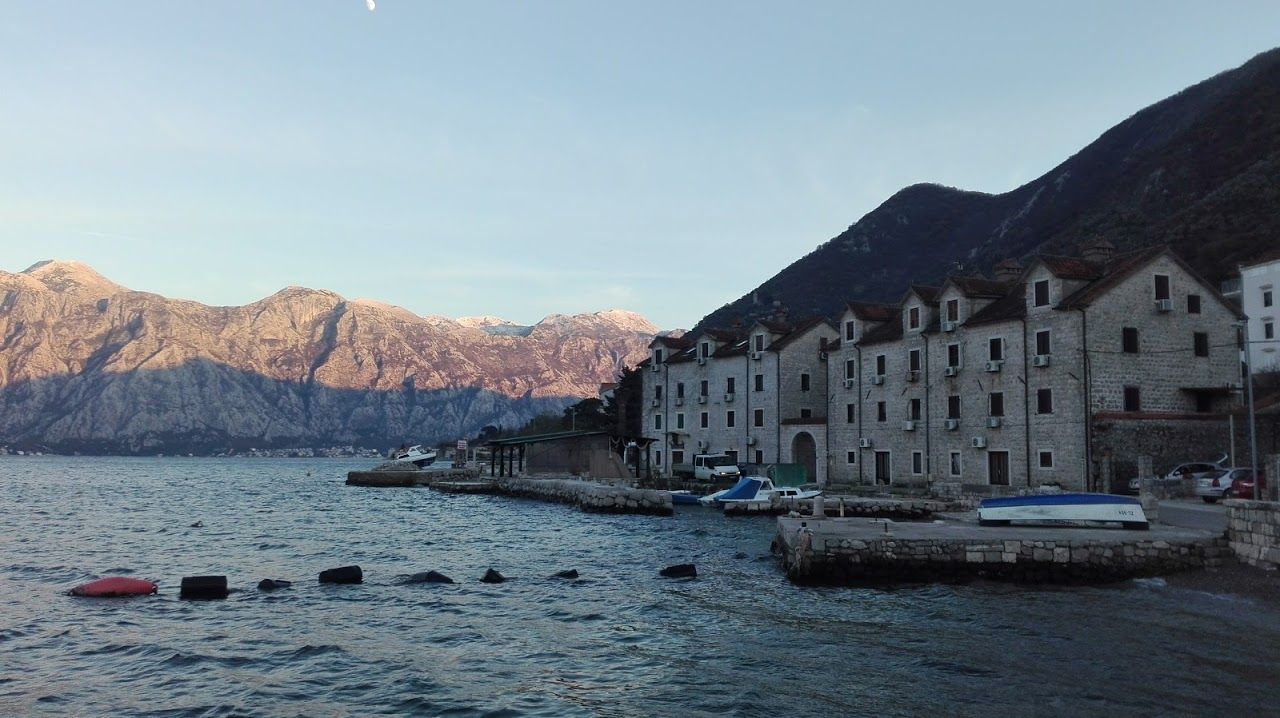 NGO Kamelija Stoliv has organized the traditional event of Kostanjada since 2006. The party feast is always at the end of October or early November, on the occasion of All Saints. Namely, Stoliv had an unwritten law for collecting chestnuts - until 1 November no one was allowed to enter another person's property to gather chestnut fruit. After that date, no one was defending; the goal was to collect as much fruit as possible, to save it from decay. Reminding of this beautiful custom, the NGO Kamelija organizes a tasting of sweet and salty chestnut dishes, a suitable cultural and artistic program, as well as art colony on the chestnut theme, as well as a walk through the centuries-old plantation to Gornji Stoliv.
NGO Kamelija Stoliv has organized the traditional event of Kostanjada since 2006. The party feast is always at the end of October or early November, on the occasion of All Saints. Namely, Stoliv had an unwritten law for collecting chestnuts - until 1 November no one was allowed to enter another person's property to gather chestnut fruit. After that date, no one was defending; the goal was to collect as much fruit as possible, to save it from decay. Reminding of this beautiful custom, the NGO Kamelija organizes a tasting of sweet and salty chestnut dishes, a suitable cultural and artistic program, as well as art colony on the chestnut theme, as well as a walk through the centuries-old plantation to Gornji Stoliv.December 21, 2018 - Buducnost Voli lost to Fenerbahçe 89:65 in the 14th Round of the Euro league. Buducnost played great for 25 great minutes but obviously did not have the strength to keep up with the visiting team. The Turkish team was excellent in the shot, they scored 15 three-points, Buducnost only 4 and in that ratio, there was no chance for another surprise in Podgorica.
Erl Clark was the most effective for Buducnost with 15 points, Petar Popovic played the best game of the season and scored 12 points, Gordic 11, though mostly all of this happened in the first quarter.
For the visiting team, Veseli scored 29 points, Loverj 17, and Slukas 11.
Buducnost Voli recorded their 11th defeat of this season in this elite competition.
Text by CdM, on December 20th 2018, read more at CdM
December 21, 2018 - Mega Bemax basketball player Goga Bitadze will sign a contract with Budućnost Voli today, CdM finds out.
The Georgian representative plays the center position and is one of the best young players in Europe in this position.
He showed his class 10 days ago in Podgorica when he scored 23 points in the match with the regional champion.
In the current season, he scored an average 20 points in the ABA League, with eight rebounds.
He's 19 years old, and he came to Mega three seasons ago.
Text by CdM, on December 20th, 2018, read more at CdM
December 21, 2018 - The winter tourist season was officially opened at the ski center Vučje near Nikšić today. This year, one of the novelties in the ski center Vučje is the offer of domestic products from family farms, such as homemade ham, sausages, cheeses and the like.
"It is especially satisfying that the weather conditions this year will be beneficial to the winter centers. The real additional qualities and benefits when we talk about this offer are domestic products from Vučje. The center of Vučje and what is produced in Vučje will be presented to all the guests who stay in these facilities, and then even in the wider region, "said Zeljka Radak Kukavicic, director of the NTO.
State Secretary in the Ministry of Sustainable Development and Tourism Damir Davidovic said that from the aspect of the Ministry's policy, in the next year, linking agriculture and tourism is something that will be given a special priority.
"The season in Montenegro has so far been clearly linked to the coast, the sun and the sea, and now in the north, extra accommodation units are being requested because of the great interest that exists for this area," added Davidovic.
During the past year, the Municipality of Niksic, together with the Directorate for Transport, managed to complete the artificial snow, which is located near the track, said the Mayor of Niksic.
"The artificial snow is on the surface of one hectare and certainly has about 30 thousand liters of water, which will be necessary for refreshment in the next winter season, where Jovović’s should purchase snow refreshers and I hope that together with the Ministry of Tourism and NTO this will be organized, because it is really necessary," mayor of Niksic said.
Since the ownership structure on Vucje has been completed, much has been done. Every year we are seeing an increase in the number of visitors, and we expect the same this year as well, because Vucje is one specific ski center that offers warmth," said Slavica Grgurevic from TO Niksic.
Text by Info Biro, on December 20th, 2018, read more at CdM
20 December 2018 - The Ministry of Finance developed an Autumn analysis of macroeconomic trends and structural reforms in cooperation with other relevant institutions. The autumn analysis included economic trends and growth in the first nine months of 2018.
"The environment is characterised by a moderate and less balanced growth of the world economy," said Iva Vuković, Director General for Economic and Development Policy at the Ministry of Finance, adding that these trends are significantly influenced by rising geopolitical tensions, trade restrictions between the USA and China, and the rise in crude oil prices on the world market.
The World Bank and the IMF revised their projections for the countries of the Western Balkans, so the forecast for the western Balkan countries was 3.5%, while for Montenegro, the Workl Bank revised the projection for 2018 to 3.8%, or the whole 1 pp. more than the original estimates.
Director General Iva Vuković said that in 2017 the level of investments was worth 1.1 billion EUR, and that according to the latest government projections, this level of investment should be close to 1.5 billion EUR at the end of this year and that the achieved results of economic growth were also contributed by excellent tourism revenues, which grew by 8.3% in the first nine months, thus reaching the level of tourism income realised during the whole year of 2017; tourism revenues in 2018 are projected to exceed 1 billion EUR.
"I would also stress industrial production's growth of 24% and a significant increase in electricity based on favourable hydrological conditions and new capacities", she pointed out.
Positive trends in economic teems also reflected the movement of indicators in the labour market and the latest available data for 9 months indicate that the labour activity rate has risen to 57.6%.
Employment grew at a rate of 3.1%, while the unemployment rate was further reduced to 14.1%.
"The current account deficit has grown by 32% and is a consequence of foreign trade deficit and reduced surplus of primary incomes. The trade deficit amounted to 1.5 billion EUR, while we had a surplus of services that grew by 11.2%. Net exports are negative, but we expect a strong impact on tourism and metal exports to reduce the negative contribution of net exports to real GDP growth. According to government projections, the current account deficit will amount to 18.1% of GDP at the end of this year, which is 2$ more than in 2017," Director General Vuković said.
The projection is that by the end of the year, the public finance deficit will amount to 135.5 million EUR (2.9% of GDP). The budget deficit will be 173.1 million EUR (3.8% of GDP), while the local government will have a surplus of 37 million EUR (0.8% of GDP).
Public debt at the end of 2018 will amount to 3.2 billion EUR, or 70.9% of GDP, while the state debt will total 3.1 billion EUR, or 68% of GDP.
"Priorities in the coming period remain the dynamisation of economic growth and the strengthening of the competitiveness of the economy, the continuation of the implementation of projects in all areas, implementation of measures from the fiscal strategy in order to maintain the stability of public finance and further implementation of measures and policies with the aim of attracting investment and job creation and growth earnings in the private sector," Vuković concluded.






